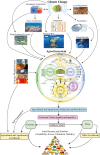Uncovering the Research Gaps to Alleviate the Negative Impacts of Climate Change on Food Security: A Review
- PMID: 35903229
- PMCID: PMC9315450
- DOI: 10.3389/fpls.2022.927535
Uncovering the Research Gaps to Alleviate the Negative Impacts of Climate Change on Food Security: A Review
Abstract
Climatic variability has been acquiring an extensive consideration due to its widespread ability to impact food production and livelihoods. Climate change has the potential to intersperse global approaches in alleviating hunger and undernutrition. It is hypothesized that climate shifts bring substantial negative impacts on food production systems, thereby intimidating food security. Vast developments have been made addressing the global climate change, undernourishment, and hunger for the last few decades, partly due to the increase in food productivity through augmented agricultural managements. However, the growing population has increased the demand for food, putting pressure on food systems. Moreover, the potential climate change impacts are still unclear more obviously at the regional scales. Climate change is expected to boost food insecurity challenges in areas already vulnerable to climate change. Human-induced climate change is expected to impact food quality, quantity, and potentiality to dispense it equitably. Global capabilities to ascertain the food security and nutritional reasonableness facing expeditious shifts in biophysical conditions are likely to be the main factors determining the level of global disease incidence. It can be apprehended that all food security components (mainly food access and utilization) likely be under indirect effect via pledged impacts on ménage, incomes, and damages to health. The corroboration supports the dire need for huge focused investments in mitigation and adaptation measures to have sustainable, climate-smart, eco-friendly, and climate stress resilient food production systems. In this paper, we discussed the foremost pathways of how climate change impacts our food production systems as well as the social, and economic factors that in the mastery of unbiased food distribution. Likewise, we analyze the research gaps and biases about climate change and food security. Climate change is often responsible for food insecurity issues, not focusing on the fact that food production systems have magnified the climate change process. Provided the critical threats to food security, the focus needs to be shifted to an implementation oriented-agenda to potentially cope with current challenges. Therefore, this review seeks to have a more unprejudiced view and thus interpret the fusion association between climate change and food security by imperatively scrutinizing all factors.
Keywords: climate adaptation; climate-smart food; environmental stresses; food safety; future crops; implementation challenges.
Copyright © 2022 Farooq, Uzair, Raza, Habib, Xu, Yousuf, Yang and Ramzan Khan.
Conflict of interest statement
The authors declare that the research was conducted in the absence of any commercial or financial relationships that could be construed as a potential conflict of interest.
Figures








Similar articles
-
Climate change impacts on global food security.Science. 2013 Aug 2;341(6145):508-13. doi: 10.1126/science.1239402. Science. 2013. PMID: 23908229 Review.
-
Climate change and nutrition: creating a climate for nutrition security.Food Nutr Bull. 2013 Dec;34(4):533-47. doi: 10.1177/156482651303400415. Food Nutr Bull. 2013. PMID: 24605700
-
Climate Change and Global Food Systems: Potential Impacts on Food Security and Undernutrition.Annu Rev Public Health. 2017 Mar 20;38:259-277. doi: 10.1146/annurev-publhealth-031816-044356. Epub 2017 Jan 6. Annu Rev Public Health. 2017. PMID: 28125383 Review.
-
Multi-impacts of climate change and mitigation strategies in Nigeria: agricultural production and food security.Sci One Health. 2025 May 16;4:100113. doi: 10.1016/j.soh.2025.100113. eCollection 2025. Sci One Health. 2025. PMID: 40521404 Free PMC article. Review.
-
Health Risks and Costs of Climate Variability and Change.In: Mock CN, Nugent R, Kobusingye O, Smith KR, editors. Injury Prevention and Environmental Health. 3rd edition. Washington (DC): The International Bank for Reconstruction and Development / The World Bank; 2017 Oct 27. Chapter 8. In: Mock CN, Nugent R, Kobusingye O, Smith KR, editors. Injury Prevention and Environmental Health. 3rd edition. Washington (DC): The International Bank for Reconstruction and Development / The World Bank; 2017 Oct 27. Chapter 8. PMID: 30212118 Free Books & Documents. Review.
Cited by
-
The rhizobacterial Priestia megaterium strain SH-19 mitigates the hazardous effects of heat stress via an endogenous secondary metabolite elucidation network and molecular regulation signalling.BMC Plant Biol. 2024 Sep 4;24(1):827. doi: 10.1186/s12870-024-05534-2. BMC Plant Biol. 2024. PMID: 39227801 Free PMC article.
-
Melatonin as an Efficient and Eco-Friendly Tool to Increase Yield and to Maintain Quality Attributes during Lemon Storage.Int J Mol Sci. 2024 Sep 18;25(18):10025. doi: 10.3390/ijms251810025. Int J Mol Sci. 2024. PMID: 39337511 Free PMC article.
-
Function and regulation of plant ARGONAUTE proteins in response to environmental challenges: a review.PeerJ. 2024 Mar 26;12:e17115. doi: 10.7717/peerj.17115. eCollection 2024. PeerJ. 2024. PMID: 38560454 Free PMC article. Review.
-
Salinity Mitigates the Negative Effect of Elevated Temperatures on Photosynthesis in the C3-C4 Intermediate Species Sedobassia sedoides.Plants (Basel). 2024 Mar 12;13(6):800. doi: 10.3390/plants13060800. Plants (Basel). 2024. PMID: 38592796 Free PMC article.
-
Tolerant mechanism of model legume plant Medicago truncatula to drought, salt, and cold stresses.Front Plant Sci. 2022 Sep 7;13:847166. doi: 10.3389/fpls.2022.847166. eCollection 2022. Front Plant Sci. 2022. PMID: 36160994 Free PMC article. Review.
References
-
- Abbasi Z. A. K., Nawaz A. (2020). Impact of climate change awareness on climate change adaptions and climate change adaptation issues. Pak. J. Agric. Res. 36 619–636. 10.17582/JOURNAL.PJAR/2020/33.3.619.636 - DOI
-
- Abdullah D., Shah T., Ali S., Ahmad W., Din I. U., et al. (2019). Factors affecting household food security in rural northern hinterland of Pakistan. J. Saudi Soc. Agric. Sci. 18 201–210. 10.1016/J.JSSAS.2017.05.003 - DOI
-
- Adnan S., Ullah K., Ahmed R. (2020). Variability in meteorological parameters and their impact on evapotranspiration in a humid zone of Pakistan. Meteorol. Appl. 27:e1859. 10.1002/MET.1859 - DOI
-
- Affognon H., Mutungi C., Sanginga P., Borgemeister C. (2015). Unpacking postharvest losses in sub-Saharan Africa: a meta-analysis. World Dev. 66 49–68. 10.1016/J.WORLDDEV.2014.08.002 - DOI
Publication types
LinkOut - more resources
Full Text Sources

